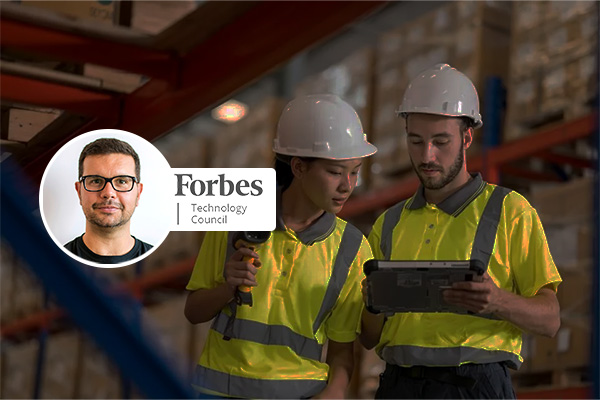The versatility of real-time locating systems (RTLS) and location-based services (LBS) is remarkable. They can be used to monitor crowd capacity at entertainment venues, tag and track priceless artworks in museums, and monitor inventory in manufacturing and logistics. The power of this technology is really only now being fully realised.
As RTLS applications expand, so does a massive network of assets and devices equipped with positioning technology. This is happening in offices, logistics hubs, hospitals, factories, sports arenas, and anywhere else you can think of. Such smart positioning systems – and the software and hardware that go with them – can come in many different forms. But as applications for RTLS become more complex and diverse, they also require more flexible solutions. Unfortunately, current approaches are often siloed and lead to significant fragmentation.
Often the same asset needs to be positioned and located both indoors and outdoors. So it no longer works to consider indoor and outdoor positioning as separate entities in their own environments. Instead, we are entering the era of Hybrid RTLS, where an object can be moved seamlessly between facilities and environments.
The RTLS Solutions of Today
Each form of asset tracking depends on the operating environment and overall objectives. There are three primary RTLS solutions, that I’ll explain and then share how they can be incorporated into a complete ecosystem.
Infraless RTLS
Infraless RTLS stands for Infrastructure-less Real-Time Locating System. It is a technology that tracks and locates objects in real time without relying on any specific local physical infrastructure.
When operating outdoors, Infraless RTLS is an ideal system: installing permanent locating hardware is only particularly feasible under a roof or in a building. However, Infraless RTLS can also be used indoors in environments where presence/absence detection is sufficient – when you don’t need to know the exact coordinates of the asset but simply want to know if it’s there effectively making use of existing communications infrastructure. Typically, Infraless RTLS systems attach tags to assets that communicate via wireless channels such as Bluetooth® Low Energy and GPS.
Tagless RTLS
Tagless RTLS refers to a locating system that allows objects to be tracked without the need to attach traditional active tags to the asset. Instead, assets are equipped with small, flexible and very low-cost (passive, battery-free) devices such as stickers with printed barcode, QR code or RFID antennae.
Similar to Infraless RTLS, the location of the asset is linked to the location and timestamp of when the handheld mobile device or reader (phone, tablet or scanner) reads the information from the sticker. If you need to track a large number of assets, tagless RTLS may be the best option for you. Tags can be expensive, and the costs add up quickly. The idea here is that companies want to know where objects are without over-investing in technology.
Unlimited RTLS
Unlimited RTLS refers to a Real-Time Locating System that provides reliable, continuous and real-time seamless asset tracking capabilities without practical limitations on the number of objects, accuracy and latency, effectively allowing many different use cases to run simultaneously in the same environment. It aims to overcome the scalability limitations often associated with traditional RTLS solutions and uses asset tags and dedicated infrastructure.
While Infraless and Tagless RTLS can be seen as specific solution types to optimise investment costs, Unlimited RTLS is designed to achieve full visibility of the monitoring environment, suitable for the most demanding requirements and supporting multiple use cases in parallel. In my experience, projects and solutions tend to move to Unlimited RTLS over time, even if they originally started with milder constraints suitable for either Infraless or Tagless RTLS.

How to Develop an Ecosystem
When developing an RTLS solution, first determine your use cases and then consider how many use cases you need to fulfil to achieve your ROI (return on investment). Are you primarily concerned with streamlining logistics and tracking goods? Are you looking for monitoring? What about improved delivery options? Process optimisation?
Once you have pinpointed your use cases and the scale required, you can determine which RTLS options you need to implement and where. It’s best to identify one or two main use cases, build an ecosystem from there and gain access to the different components of your solution: tags, stickers, tracking infrastructure, scanners, etc. By thinking like an ecosystem, we can overcome the risk of fragmentation and ensure that all parts of your solutions inherently work together.
To develop such a functional positioning ecosystem, asset tracking should involve different systems along a supply chain. That’s why Hybrid RTLS is the way forward, combining locating technologies in different environments.
Such continuous and seamless tracking can be achieved by implementing multiple types of solutions across different environments so that an asset can be moved and easily located through different positioning mechanisms. For example, an operations manager can track an asset as it moves from their logistics hub (Unlimited RTLS) to a partner’s truck (Tagless RTLS) to a customer’s doorstep (Infraless RTLS). Any bottlenecks can be identified, analysed and mitigated at any point in the process – whether indoors or outside the building.
There is no one-size-fits-all with RTLS: instead, a colourful patchwork of integrated systems is required. Bridging all the gaps in RTLS, however, does not depend solely on a single player or the end customer. It requires collaboration between different companies using RTLS technologies to integrate with their partners or even competitors. Now is the time to join forces and ensure seamless monitoring for end-to-end solutions, no matter the obstacle.
Did you know?
Quuppa is the leading RTLS platform for indoor positioning.
LEARN MORE
This article was originally published in Forbes.com

